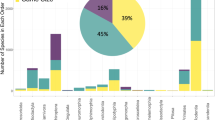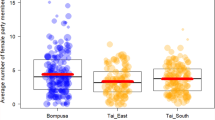Abstract
Zinner et al. question our finding that the size of a female wild baboon's sexual swellings predicts her lifetime reproductive success, suggesting that we should have controlled for female height in our analyses of female fitness. But the issue is not whether a female's fitness is independent of her height, but whether males draw inferences about her fitness from her sexual swelling, and do so independently of her height. Our results indicate that they do1,2, supporting the hypothesis that sexual swellings advertise female reproductive value.
Similar content being viewed by others
Domb and Pagel reply
There is no record to suggest that male baboons, or male primates of any species, prefer taller females. We have shown that males base their costly mating behaviours on the female's swelling size and not on female height, age or social rank. The amount of aggression from other males that a male must tolerate to consort a female (the key male behavioural trait2) is positively correlated with the size of her swelling (swelling length), statistically controlling for the effects of female height, age and rank (r = 0.59, n = 13). By comparison, males do not receive more aggression for consorting taller females (r = 0.41, n = 13; r = −0.069, n = 13, controlling for swelling size; r = −0.25 controlling for swelling size, female age and female family rank). Contrary to the claim by Zinner et al., we did control for troop differences in these analyses1,2, and in a way that normalized the variances, unlike their approach, which neglects this statistical assumption.
The suggestion of Zinner et al. that we should have analysed male interest in females' swellings when more than one female was in oestrus is based on a misinterpretation of our results. We followed an individual focal female, and not all oestrous females simultaneously. Focal females were not selected according to their swelling size. If two females were simultaneously in their maximally swollen phase, male interest towards the focal female at any given period would be influenced by the presence of the other female; if the other female's swelling was larger than that of the focal female, then male interest in the focal female could be very low.
From our results, this could be incorrectly inferred as failing to support our hypothesis. The only way to untangle such effects is to investigate all possible pairs (triples and so on) of females, following males and females simultaneously. We therefore limited our tests to those situations in which a single female was in oestrus. This procedure automatically controls for other effects and tests the hypothesis.
Zinner et al. repeat an earlier idea3,4 that swellings are probabilistic signals of the timing of ovulation, which has since fallen out of favour5,6,7. Nunn has pointed out8 that females in species with sexual swellings are attractive and mate for many more days than females in species without sexual swellings, casting further doubt on whether swellings accurately signal ovulation — in fact, they may function to confuse the timing of ovulation9,10. We tested the second hypothesis of Zinner et al. but have found no support for it2. This leaves the third hypothesis (ours): that swelling size signals enduring differences between females in their ability to conceive and raise offspring.
The contention of Zinner et al. that the reliable-indicator hypothesis is unsupported is therefore based on a misunderstanding of this hypothesis and of our results. Males endure higher costs to mate with females with larger sexual swellings2, but not with those that are taller1. Females with larger sexual swellings also have higher lifetime reproductive success2. Baboons provide little or no paternal care, and male–male aggression over females is costly. It is important for males to direct their mating efforts towards the females of the highest fitness, and male selectivity, in turn, makes it advantageous for females to advertise their quality. The size of the sexual swelling seems to do just this.
References
Domb, L. G. Sexual Swellings in Wild Baboons (Papio cynocephalus anubis) at Gombe National Park, Tanzania. Thesis, Harvard Univ. (2000).
Domb, L. G. & Pagel, M. Nature 410, 204–206 (2001).
Hausfater, G. Dominance and Reproduction in Baboons (Karger, Basel, 1975).
Hamilton, W. J. in Primate Paternalism (ed. Taub, D. M.) 309–335 (Van Nostrand Reinhold, New York, 1984).
Thompson, J. et al. Biol. Reprod. 46, 879–884 (1992).
Heistermann, M., Mohle, U., Vervaecke, H., van Elsacker, L. & Hodges, J. Biol. Reprod. 55, 844–853 (1996).
Whitten, P. & Russell, E. Am. J. Primatol. 40, 67–82 (1996).
Nunn, C. L. Anim. Behav. 58, 229–246 (1999).
Boesch, C. & Boesch-Achermann, H. The Chimpanzees of the Tai Forest: Behavioral Ecology and Evolution (Oxford Univ. Press, New York, 2000).
Wrangham, R. in Behavioral Diversity in Chimpanzees and Bonobos (eds Boesch, C., Hohmann, G. & Marchant, L.) (Cambridge Univ. Press, Cambridge, 2002).
Author information
Authors and Affiliations
Corresponding author
Rights and permissions
About this article
Cite this article
Domb, L., Pagel, M. Significance of primate sexual swellings. Nature 420, 143 (2002). https://doi.org/10.1038/420143a
Issue Date:
DOI: https://doi.org/10.1038/420143a
This article is cited by
-
Secondary sexual characters and female quality in primates
Behavioral Ecology and Sociobiology (2006)
-
Male Mate Choice in Lemur catta
International Journal of Primatology (2006)
Comments
By submitting a comment you agree to abide by our Terms and Community Guidelines. If you find something abusive or that does not comply with our terms or guidelines please flag it as inappropriate.



